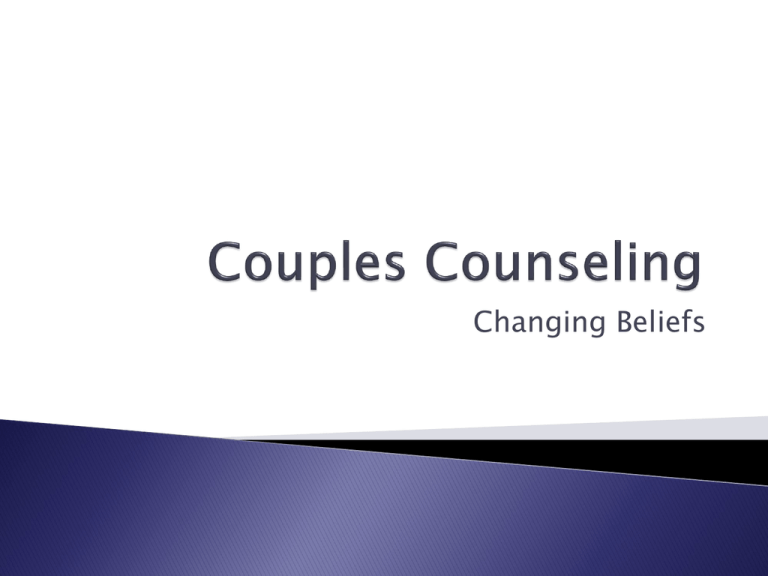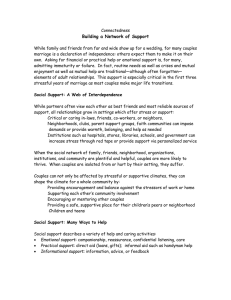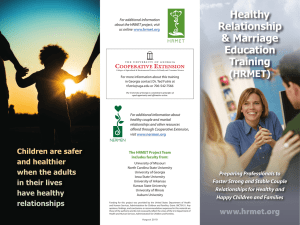Changing Beliefs
advertisement

Changing Beliefs 1886 - Freud began therapeutic practice and research in Vienna. 1911 - Alfred Adler 1913 - Carl Jung 1942 - Carl Rogers 1951 The seminal work of Gestalt Therapy is published Fritz Perls 1952 - The Diagnostic and Statistical Manual of Mental Disorders (DSM) 1953 - B.F. Skinner 1954 - Abraham Maslow 1957 - Albert Ellis 1967 - Aaron Beck 1968 - DSM II published 1930 to 1963 1929 to 1932 - Three marital clinics opened; they were service and education oriented, and saw mostly individuals The closest thing to theory was what was borrowed from psychoanalytic - interlocking neurosis 1931 the first marital therapy paper was published Theory was marginalized due to a lack of brilliant theorists, and a lack of distinction from individual analysis 1931 to 1966 Mostly individual sessions, but some conjoint; still treated like seeing two individual clients in the same room though Some started to downplay the role of the therapist Family was outshining couples work, and the couple techniques weren't innovative or particularly effective 1963 to 1985 Family therapy overpowers couples, even though a number of big name people really mostly saw couples Jackson- Coined concepts like quid pro quo, homeostasis, and double bind for conjoint therapy Satir - Coined naming roles members played, fostered self-esteem and actualization, and saw the therapist as a nurturing teacher Bowen - Multigenerational theory approach, with differentiation, triangulation, and projection processes, with the therapist as an anxietylowering coach - societal projection process was the forerunner of our modern awareness of cultural differences Haley - Power and control (or love and connection) were key. Avoided insight, emotional catharsis, conscious power plays. Saw system as more, and more important, than the sum of the parts 1986 to present New Theories were tried and refined, like Behavioral Marital Therapy, Emotionally Focused Therapy, and Insight-Oriented Marital Therapy. Couples therapy was used to treat depression, anxiety, and alcoholism. Efforts were focused on preventing couples problems with programs like PREP Feminism, Multiculturalism, and Post-Modernism impacted the field Eclectic integration, brief therapy, and sex therapy ideas were incorporated as well into our work. As early as 1960, Gurin, Veroff, and Feld found that over 40% of all people seeking psychological help viewed the nature of their problem as marital. Manus argued in 1966 that couples counseling was a “technique in search of a theory” with little conceptual clarity in evidence (Jacobson & Gurman, 1995). Olson (1970), the field’s first chronicler, referred to marital therapy as a “youngster” which had “not yet developed a solid theoretical base nor tested its major assumptions and principles.” Six years later he wrote, the field was “no longer in its infancy” and was “showing signs of maturing,” although it “appeared like an adolescent, full of undirected energy.” 1970’s – 1980’s ◦ Family counseling “killed marriage counseling” and did not see it as independent, different, or important. ◦ This time period was seen as “family therapy’s golden age.” Even in the early 1980’s couples counseling struggled to have a place. Haley (1984) put it, “marriage counseling did not seem relevant to the developing family therapy field.” It was seen that marriage counselors adopted the ideas of other therapies rather than developing their own. Going back to the mid 1960’s to mid 1980’s only a few new models appeared and only a handful of important texts appeared. By the mid-1980’s, couple therapy had reasserted its existence and established what would become more sustained theory development and empirical research. 1986 was the beginning of couple therapy’s fourth and current phase. 1940’s only 5% of marriage counseling met conjointly 1950’s rose to 9% 1960’s increased to 15% Not until 1970’s did conjoint therapy become the predominant technique of couples counseling. 1965 George Bach published “the intimate enemy” which was a new approach to couples’ therapy. Problem was that people needed to air their anger rather than suppress it Expressing resentments would be a catharsis that would clear the air Partners took turns airing their resentments We now know that there is no catharsis effect in voicing anger and that Back’s procedure only built resentment. Quid Pro Quo ◦ A good relationship is based on reciprocating positive behaviors and that a bad marriage is caused by a breakdown of this contract. Contingency contracting “give to get” ◦ Each person would identify what behaviors they wanted to get from the other ◦ Counselor would help couple to write a contract for the exchange of desired behaviors. 1977 Murstein found that a reciprocity concept was a hallmark of an ailing relationship…not a happy one. People became “affective accountants” when a relationship wasn’t working well. ◦ “I did this for her, and she never reciprocated.” When the relationship goes well, they don’t think of this contingency. Goal was to have couple identify their problem and them help resolve them. Therapist was seen as “super problem-solver” Could start anywhere and teach a specific set of relationship skills Belief was that when specific skills were taught all conflicts would be solved. Focus on resolution of conflict is misguided. Gottman’s research revealed that most conflict (69%) in relationships is perpetual. ◦ Based on lasting differences in personalities and needs. Couples need to dialogue about perpetual issues or live in a state of ‘gridlock’ Goal is to manage conflicts rather than resolve them. Focus on teaching skills System therapists taught: ◦ Avoiding mindreading, establishing clear feedback loops, being able to meta-communicate about double binding messages. Rogerian and behavior therapists taught: ◦ Active listening to one another If you teach skills, these are what need to be taught. In happy, lasting relationships: The approach toward conflict is gentle. Partners soften the way they bring up an issue Partners accept influence from one another Relationships have a 5:1 ratio of positive to negative affect during conflict ◦ Consistently communicate acceptance of one another ◦ ◦ ◦ ◦ In happy, lasting relationships: ◦ They keep their level of physiological arousal low ◦ They pre-empt negativity in the interaction ◦ They repair the interaction and de-escalate if it does become negative ◦ They move gently toward compromise In relationships that are ailing and failing: ◦ There is either an escalation of negative affect, ◦ a lack of positive affect, ◦ or a state of emotional disengagement Assumed all conflicts were alike Some conflicts are real deal-breakers ◦ These conflicts contain ‘hidden agenda’ ◦ Partners have the same argument over and over ◦ Positions are embedded with deep personal meaning so that compromise seems completely unthinkable Need to help couples talk about deeper meaning ◦ Freedom, power, love, and justice 1970s therapy had a strong behavioral and cognitive base. Therapist was the rational and calm one. Couple was viewed as emotional and out of control. Following Bowen’s ideas, our job was to help the couple control their feelings. Bowen believed that the partners would control their emotion using reason. The counselor was assisting each partner’s cerebral cortex in gaining dominance over the primitive limbic system. It was emotion versus reason, and reason should win. Goal was supporting the process of evolution. Bowen’s views about the brain and emotion versus reason are wrong. In the brain there is an integration of emotion and reason Without emotion, problems do not get solved very well. Emotion, prioritizing figure from ground, and the intuitive ‘sense of the matter’ are essential in problem solving. People are not rational decision makers. Expressing emotion does not mean being ‘out of control’. Emotion is central to the understanding and treatment of couples’ relationships. Gottman’s research shows that the nature of emotional interaction predicts what happens to a relationship. Affect is not the problem; it is central for understanding, compassion, and change. We need to become the expert on emotion, and on helping couples establish emotional connection. Bowen believed the goal was to help partners become less ‘enmeshed’ and more ‘differentiated.’ Dependency is now legitimate in relationships. Based on attachment theory, the partners are no longer seen as either dependent or independent. Dependency is seen as either effective or ineffective. Believed that couples needed to reduce negative affect and build positive affect. Goal of therapy was to help couples schedule ‘love days’ designed to increase positive behavior between partners. Building positive affect both during conflict and in everyday interaction is essential to ensure lasting change. ‘Love days’ didn’t change positive affect during conflict. To increase positive affect, need to focus on improving both the couple’s friendship and secure attachment. Assumed that if we dealt with conflict, the positive affect systems would be activated automatically. Positive affect systems must be build and maintained intentionally as part of therapy To build positive affect and secure attachment, couples need to work on ◦ turning toward bids for emotional connection, ◦ building emotional intimacy, and ◦ building positive affect systems such as courtship, romance, lust, sex, play, fun, and adventure Growing awareness that good friendship, positive affect systems, and constructive conflict need to be supplemented by building the couple’s shared meaning system. Couples need to identify and communicate ◦ their sense of purpose, ◦ the meaning of how they move through time together, ◦ their priorities and values, ◦ what they hold to be sacred ◦ their goals and missions, ethics, morality, ◦ philosophy of life and religion ◦ their legacy from their families and culture Goal is to build an existential base to their lives
![-----Original Message----- From: [ ]](http://s2.studylib.net/store/data/015586613_1-8c9b50a3f3a183d8c5aafe1c583083c8-300x300.png)
![-----Original Message----- From: maureenwalsh [ ]](http://s2.studylib.net/store/data/015586604_1-c3fa6c8bd493b12e05ad4066085506c1-300x300.png)


